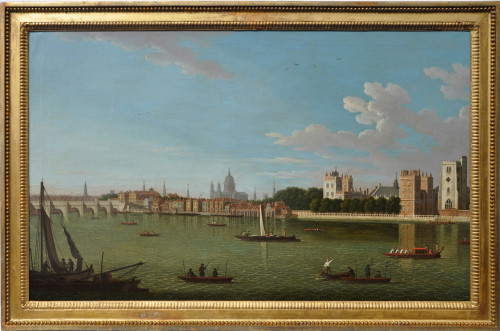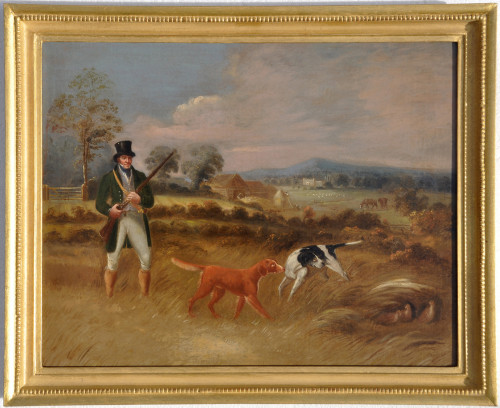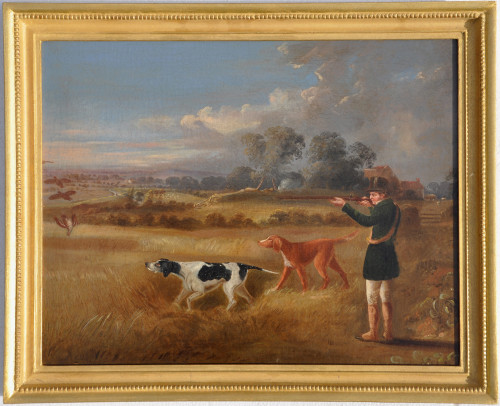A View of the Thames from Richmond Hill with Windsor Castle in the distance, a Couple watching an Artist painting and a Dragoon Officer and a Lady nearby
A View of the Thames from Richmond Hill with Windsor Castle in the distance, a Couple watching an Artist painting and a Dragoon Officer and a Lady nearby
Attributed to THOMAS CHRISTOPHER HOFLAND RBA
1777-1843
English School
A View of the Thames from Richmond Hill with Windsor Castle in the distance, a Couple watching an Artist painting and a Dragoon Officer and a Lady nearby
Oil on canvas
This view, near the top of Petersham Common, was a favourite of artists in the 18th and 19th centuries. It looked out between the Star and Garter Hotel and Wick House, a vista which is now obscured by trees and other dense foliage.
Thomas Christopher Hofland, was born at Worksop on Christmas Day, 1777, the son of a skilled manufacturer of machinery used in cotton mills. His stay in the town of his birth was brief though for his father was living in Lambeth in 1780 but his business from thence forward was unsuccessful.
Thomas Christopher was largely self-taught as a painter although for a while he did receive instruction from the landscape painter John Rathbone and he resolved to become a professional painter to help his family after the ruin of their business. He was primarily a landscape painter and he travelled all over England, Scotland, Wales and Ireland to find his subject-matter. In England, he particularly favoured the Lake District, Yorkshire and Derbyshire as well as numerous views along the Thames, particularly Richmond as he lived in Kew from 1799 to 1806 and was back in Richmond by about 1839 having resided in several London addresses in between including Twickenham, Hammersmith, Kensington, Newman Street and Bedford Square.
He was a keen angler and it seems to be more than coincidence that many of the places that he painted happened to be noted for their fishing. So knowledgeable was he of his craft that the books which he illustrated, "The Angler's Guide" published in 1839, and "Hofland's Fancy", were renowned amongst aficionados of fly fishing. Grant says of him that he 'never failed to repair to the river bank wherever he found himself'.
Hofland found many patrons from some highly influential figures for his work, including George III, who commissioned him to produce a series of drawings of the plants and flowers which had recently come into the Royal Gardens. He also painted houses for their owners and there are frequent examples of "White Knights, seat of the Duke of Marlborough". This house, near Reading, was recorded by Hofland as an illustrated account in a book published in 1819 although the work on it was started in 1816. It seems that the Duke never paid the artist for his work, even though Hofland had paid to publish the volume. His wife, Barbara Hofland, who was a well-known author, had also contributed some small works to the book and in 1827 she came across the Duke. She wrote: "…in excellent health and high spirits saying however not a word of paying my husband a shilling of all that he owes him and which is unquestionably gone for ever".
One of the founder members of the Royal Society of British Artists, he exhibited 118 works there with a further 72 at the Royal Academy and 141 at the British Institute. Examples of exhibited works include: "Landscape and figures - evening. 'The sun has lost his rage etc.'", "A view of Richmond Hill from Twickenham Ferry", "A view from Richmond Hill - evening. 'Heave'ns, what a goodly prospect spreads around etc'", "View of Edinburgh, taken near Cannon Mills", "Roach, dace and minnow", "Dead game", "A lime-kiln near Knaresborough" and "The Campagna of Rome with the Ruins of the Aqueduct".
In 1840 he had commissions from the Earl of Egremont to make sketches in Italy and he spent nine months there before returning to England to work them up into paintings. He became ill though and travelled to Leamington to seek medical advice but died there on 3rd January 1843.
His son, Thomas Richard, exhibited twice at the British Institute and both works were Italian views, one taken from a sketch by his father, suggesting that perhaps they visited that country together.
Examples of Hofland's paintings are held in the collections of Tate Britain, Derby Museum and Art Gallery, Orleans Museum, Richmond; Christchurch Manor Galleries, Ipswich, Victoria and Albert Museum, Ranger's House, Blackheath; Westminster School and the Government Art Collection.
Bibliography:
A Dictionary of British Landscape Painters - M H Wood
The Dictionary of Victorian Painters - Christopher Wood
Landscape in Britain, 1750-1850 - Tate Gallery 1973
Dimensions:
RELATED ITEMS






















